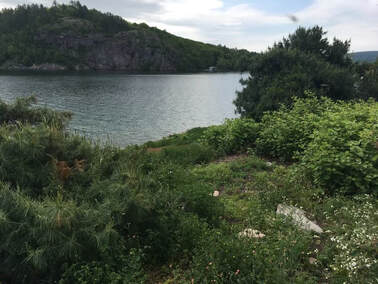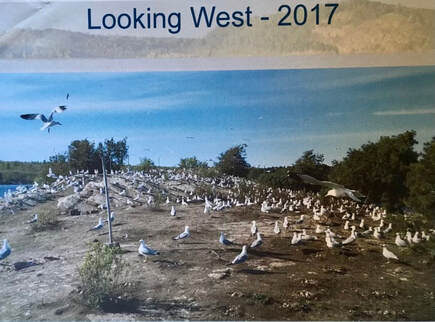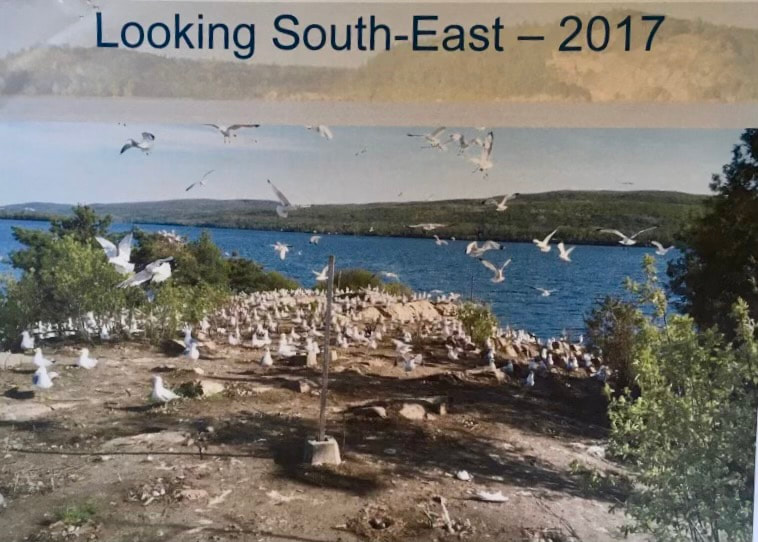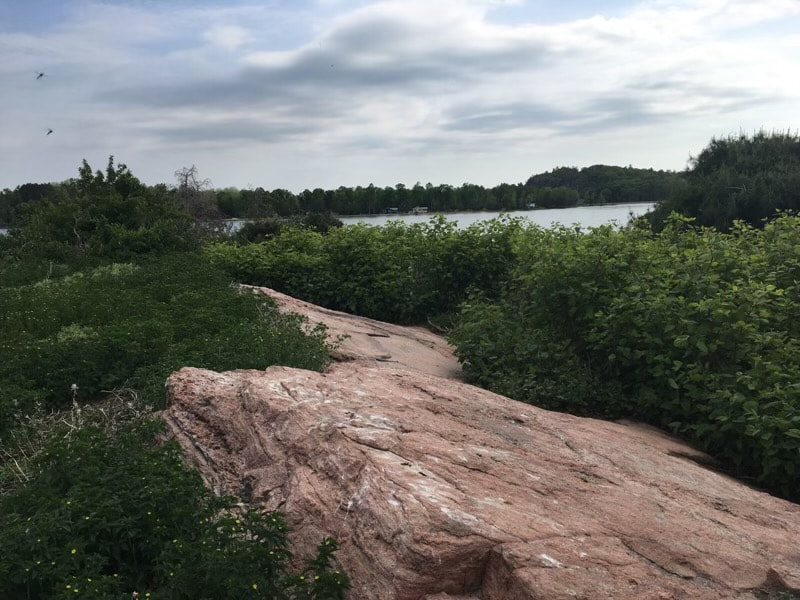Seagull Management

SEAGULL MANAGEMENT PLAN FOR LORNIE FORAN ISLAND
Written by: Roy Shultis
May 2021
The Lake Clear Conservancy (LCC) acquired Lornie Foran Island in 2006. Seagulls breeding on the island went from being a nuisance at that time to being a water quality problem in subsequent years, as indicated by higher phosphorus and E. coli levels around the island, and more concerningly, at Buelow Beach, which serves the public.
As seagulls are a protected species, the LCC, as the owner of the island, took the lead in addressing this issue with full support from the Lake Clear Property Owners Association (LCPOA) and in 2009 was granted an egg-oiling permit for one year by the Canadian Wildlife Services (CWS) of Environment Canada. This approach had its challenges but did achieve its purpose of reducing the number of gulls. However, in 2014 the permit requested by the LCC was denied by CWS.
The water quality around the Island generally deteriorated over the following years to the extent that the E. coli water samples taken by the Renfrew Health Unit exceeded safe limits 8 times, resulting in the closure of the public beach.
In response to an exhaustive submission in 2016, the LCC was granted a three-year egg-oiling permit from 2017 to 2019. The process required each egg to be coated with cooking oil, thus reducing the thickness of the shell and preventing the eggs from hatching. This was done around the end of May and a second time a few weeks later. There are usually 6 to 8 volunteers from both the LCC and LCPOA, and the process took 2 to 3 hours each time. It was not a pleasant task especially with hundreds of gulls flying over your head.
Another 3-year egg-oiling permit was requested for 2020. In response, the CWS recommended and subsequently approved, a one-year permit to remove and destroy the nests and eggs, as well as to use “scare tactics” (e.g., scarecrows, plastic owls) to discourage the gulls from nesting on the island. Biologists of the CWS indicated that this alternative strategy is a more effective long-term solution to discouraging seagull overpopulation. A subsequent permit containing the same activities was issued in 2021.
Written by: Roy Shultis
May 2021
The Lake Clear Conservancy (LCC) acquired Lornie Foran Island in 2006. Seagulls breeding on the island went from being a nuisance at that time to being a water quality problem in subsequent years, as indicated by higher phosphorus and E. coli levels around the island, and more concerningly, at Buelow Beach, which serves the public.
As seagulls are a protected species, the LCC, as the owner of the island, took the lead in addressing this issue with full support from the Lake Clear Property Owners Association (LCPOA) and in 2009 was granted an egg-oiling permit for one year by the Canadian Wildlife Services (CWS) of Environment Canada. This approach had its challenges but did achieve its purpose of reducing the number of gulls. However, in 2014 the permit requested by the LCC was denied by CWS.
The water quality around the Island generally deteriorated over the following years to the extent that the E. coli water samples taken by the Renfrew Health Unit exceeded safe limits 8 times, resulting in the closure of the public beach.
In response to an exhaustive submission in 2016, the LCC was granted a three-year egg-oiling permit from 2017 to 2019. The process required each egg to be coated with cooking oil, thus reducing the thickness of the shell and preventing the eggs from hatching. This was done around the end of May and a second time a few weeks later. There are usually 6 to 8 volunteers from both the LCC and LCPOA, and the process took 2 to 3 hours each time. It was not a pleasant task especially with hundreds of gulls flying over your head.
Another 3-year egg-oiling permit was requested for 2020. In response, the CWS recommended and subsequently approved, a one-year permit to remove and destroy the nests and eggs, as well as to use “scare tactics” (e.g., scarecrows, plastic owls) to discourage the gulls from nesting on the island. Biologists of the CWS indicated that this alternative strategy is a more effective long-term solution to discouraging seagull overpopulation. A subsequent permit containing the same activities was issued in 2021.
This initiative has been a tremendous success in reducing the seagull population on Lornie Foran Island and the lake in general and thus improving the water quality in that area. It is notable that in 2020 the number of gulls was reduced to 612, from 1,750 in 2017, a full 65% reduction. Also, the number of eggs has been reduced from about 2,600 to about 800 over the same period. In addition, the Public Beach E. coli testing showed good results and no beach closures.
Prior to the Seagull removal action to be taken in 2021, the LCC’s long-term Seagull Management Plan was to continue to include site modification and “scare tactics”, supported by a (CWS) permit to destroy nests and eggs so that the gulls are discouraged from nesting on the island in large numbers. Although this initiative had gone a long way toward improving the seagull situation, the concern was that the seagull population would quickly increase if the egg destruction program were discontinued and/or that the seagulls might choose another location on the lake.
On May 25, 2021, the work party arrived at Lornie Foran Island, expecting to encounter hundreds of eggs and nests, as in the past. Astonishingly, they found only two nests with a total of THREE eggs. Last year at this time, they gathered about 800 eggs from 276 nests and thought that to be a tremendous success over prior years, where up to 2,500 eggs had been oiled at one time. There is certainly evidence that the seagulls gathered on the island this year, but in far fewer numbers. Also the vegetation on the island was noticeably more - by about 50%. The work party members looked at other islands on the lake to confirm that the seagulls had not relocated their nesting site.
It is difficult to explain this drastic change or to know whether the seagulls will return to nest on Lornie Foran Island in the future. The LCC, in partnership with the LCPOA, and under the guidance of the CWS, will monitor and react accordingly in future years.
Prior to the Seagull removal action to be taken in 2021, the LCC’s long-term Seagull Management Plan was to continue to include site modification and “scare tactics”, supported by a (CWS) permit to destroy nests and eggs so that the gulls are discouraged from nesting on the island in large numbers. Although this initiative had gone a long way toward improving the seagull situation, the concern was that the seagull population would quickly increase if the egg destruction program were discontinued and/or that the seagulls might choose another location on the lake.
On May 25, 2021, the work party arrived at Lornie Foran Island, expecting to encounter hundreds of eggs and nests, as in the past. Astonishingly, they found only two nests with a total of THREE eggs. Last year at this time, they gathered about 800 eggs from 276 nests and thought that to be a tremendous success over prior years, where up to 2,500 eggs had been oiled at one time. There is certainly evidence that the seagulls gathered on the island this year, but in far fewer numbers. Also the vegetation on the island was noticeably more - by about 50%. The work party members looked at other islands on the lake to confirm that the seagulls had not relocated their nesting site.
It is difficult to explain this drastic change or to know whether the seagulls will return to nest on Lornie Foran Island in the future. The LCC, in partnership with the LCPOA, and under the guidance of the CWS, will monitor and react accordingly in future years.



